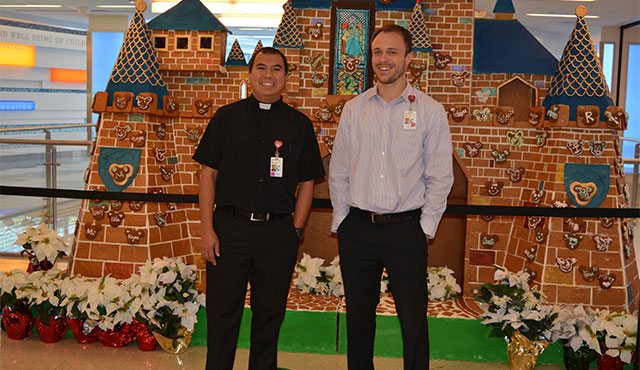ORANGE — During his initial few days as the first resident Catholic chaplain at Children’s Hospital of Orange County (CHOC), Father Ian Bustonera, A.M., was in a forgiving mood when a few of his new charges didn’t quite know what to make of him.
“There was this one little boy,” says Father Ian with a broad grin, “and I came up and said ‘Hi! I’m Father Ian.’ And he looked at me and finally said, ‘Mom, look at him. He’s wearing a Halloween costume!’”
That he managed quickly to win the young patient over has become pretty standard for Father Ian, as he fills a role that until now has been an occasional one at CHOC and that is generating much happiness among the staff and, particularly, the young patients and their families.
“It’s been almost three and a half years since we started talking about [having a full-time Catholic chaplain],” says Norman Jeune, the Lead Chaplain in the hospital’s Spiritual Care Services department. “About 40 percent of our families are Catholic, so we felt we had to have a priest as part of our team. Father Ian came to us on the recommendation of Bishop Vann, who speaks really highly of him, and now, to see a priest walking the hallways, everybody’s thrilled to see him here.”
Throughout CHOC’s existence, says Jeune, a priestly presence was maintained mostly by priests from nearby Holy Family Cathedral, who included regular hospital visits as part of their parish ministry. Jeune also started a Eucharistic ministry that now has 25 volunteers who bring Communion to CHOC patients at the hospital. But there was no consistent, daily Catholic clerical presence.
Before Father Ian began his chaplaincy, he was a parochial vicar at St. Martin de Porres Church in Yorba Linda and the local superior of his religious community, the Disciples of Mary. His hospital ministry exposure had been limited to periodic hospital calls and visiting sick parishioners. He says he was initially a bit nervous about taking on the new job, but was “inspired” when he was told my Jeune that the veteran non-Catholic Spiritual Care Services personnel would be there to support him as a member of their ministerial team.
Animated and given to bursts of laughter, Father Ian enjoys telling stories of his early encounters around the hospital.
“It’s not that difficult now because I know that I always have support,” he says. “It’s more about relationships. Now every time I walk down the hallway, it’s ‘Hi, Father! Hi, Father!’ And I’ll stop and say, ‘Hi, how are you doing?’ and I’ll start playing with the kids. There was one time…I went to the sixth floor and I heard, ‘Fatheeeeeeeer!’ And it was a nurse and she embraced me and said, ‘Thank you so much! You’re here!’”
His presence has had a pervasive effect, says Jeune.
“The way I tell it to people, we’re not just here for the crisis, it’s a relationship,” says Jeune. “For a Catholic family there’s something special about having a priest come to the bedside. They appreciate a visit with the chaplain, but there’s something special about a priest, particularly when the sacraments are involved. Everyone thinks of baptisms and anointings in the hospital, but Father Ian will perform first penance, first Communion and, when he gets permission from the bishop, will also be doing confirmations.
“The ministry here is like its own mini-parish. The priest here does many of the functions that you would see and expect in a parish. Father Ian, for many of these Catholic families, will be their priest. They won’t have an encounter with another priest because they can’t go and be in the parish setting. A lot of people don’t realize that. It’s very important that he’s here.”
In the early going, Father Ian says that he would frequently share stories about encounters with patients and parents and solicit advice from the other members of the Spiritual Care team. And, slowly, he began to develop strategies of his own.
He tells the story of visiting a young child whose mother told him the boy had an appointment for chemotherapy at 6 p.m. “He smiled at me and I got the idea he wanted me to play with him. So I sat down and played with him and 6:30 came and they didn’t take him for his therapy. I told him I had to go now, and this little boy started to cry. He had these plastic stickers and so we played with the stickers. At 7 o’clock, I really had to go, and it broke my heart, but I told him, ‘OK, I will keep all the stickers with me and I’ll bring them with me when I come back tomorrow and we’ll play then.
“Those stickers are in my car right now. It’s a learning process.”

